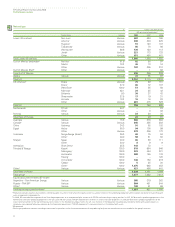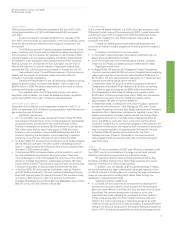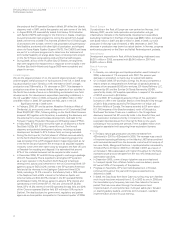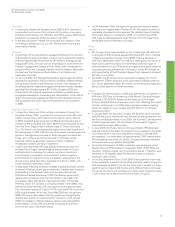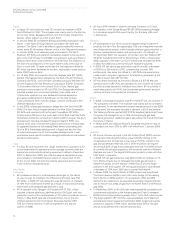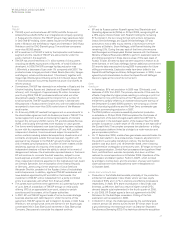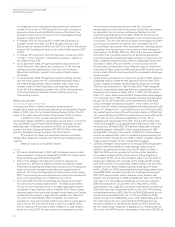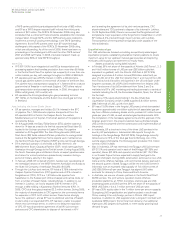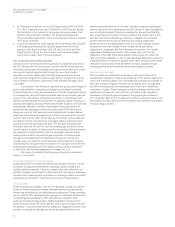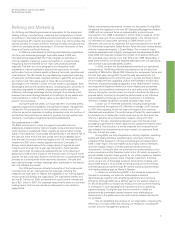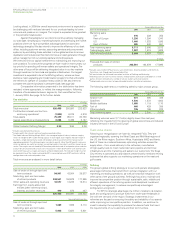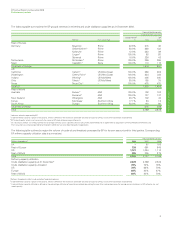BP 2008 Annual Report Download - page 24
Download and view the complete annual report
Please find page 24 of the 2008 BP annual report below. You can navigate through the pages in the report by either clicking on the pages listed below, or by using the keyword search tool below to find specific information within the annual report.
BP Annual Report and Accounts 2008
Performance review
United States
2008 liquids production at 538mb/d increased 4.9% from 2007, while
natural gas production at 2,157mmcf/d decreased 0.8% compared
with 2007.
Crude oil production increased by 32mb/d, an increase of 8%
from 2007, primarily driven by major projects in the Gulf of Mexico, partly
offset by natural reservoir decline and the impact of hurricanes in the
third quarter.
The NGLs component of liquids production decreased by 7mb/d,
driven mainly by plant turnarounds and operational issues resulting from
the hurricanes in the third quarter. BP operates or has interests in NGL
extraction plants with a processing capacity of 6.4bcf/d. These facilities
are located in major production areas across North America, including
Alberta, Canada, the US Rockies, the San Juan basin and the Gulf of
Mexico. We also own or have an interest in fractionation plants (that
separate the NGL into its component products) in Canada and the US.
Gas production was 17mmcf/d lower because of natural reservoir
decline and the impact of hurricanes, which was partly offset by
production from shale acquisitions.
Development expenditure in the US (excluding midstream) during
2008 was $4,914 million, compared with $3,861 million in 2007 and
$3,579 million in 2006. The year-on-year increase is the result of various
development projects in progress.
Our activities within the US take place in three main areas:
deepwater Gulf of Mexico, the Lower 48 states and Alaska. Significant
events during 2008 within each of these are indicated below.
Deepwater Gulf of Mexico
Deepwater Gulf of Mexico is our largest area of growth in the US. In
2008, our deepwater Gulf of Mexico liquids production was 244mb/d and
gas production was 40mboe/d.
Significant events were:
• On 14 June 2008, first oil was achieved at Thunder Horse (BP 75%
and operator). Thunder Horse is the world’s largest semi-submersible
production facility, and is located 150 miles south-east of New
Orleans. It is designed to process 250,000 barrels of oil per day and
200 million cubic feet per day of natural gas. In 2008 four wells
started up with production of around 200,000boe/d (gross) at the
year-end, signalling the completion of commissioning. Production
started up in the Thunder Horse North field in February 2009.
• On 3 April 2008, BP announced an oil discovery at its Kodiak prospect
(BP 63.75% and operator). The well, located in Mississippi Canyon
block 771, approximately 60 miles south-east of the Louisiana Coast,
is in about 1,500 metres of water.
• In September 2008, Hurricanes Gustav and Ike resulted in most of
the Gulf of Mexico’s oil production being shut down. There was
minimal damage to most of BP’s platforms other than to the drilling
derrick on the Mad Dog platform, located approximately 190 miles
south of New Orleans. The production impact of both hurricanes was
a reduction equivalent to approximately 24mboe/d for the year.
• In October 2008, BP announced an oil discovery with its Freedom
well (BP 25% and operator). The well, located in Mississippi Canyon
Block 948, approximately 70 miles south-east of the Louisiana Coast,
is in about 1,860 metres of water. It is believed that Freedom
straddles Mississippi Canyon Block 948 and Mississippi Canyon Block
992. BP owns a 67.75% interest in Block 992.
Lower 48 states
In the Lower 48 states (onshore), our 2008 natural gas production was
325mboe/d, which was up 2% compared with 2007. Liquids production
was 97mb/d, down 10% compared with 2007. Total 2008 production,
excluding the impacts from the 2008 hurricanes, was broadly flat
compared with 2007.
In 2008, we drilled approximately 540 wells as operator and
continued to maintain a stable programme of drilling activity throughout
the year.
Production is derived from two main areas:
• In the western basins (Colorado, New Mexico and Wyoming), our
assets produced 224mboe/d in 2008.
• In the Gulf Coast and mid-continental basins (Kansas, Louisiana,
Oklahoma and Texas), our assets produced 198mboe/d in 2008.
Significant events were:
• In August 2008, BP acquired all Chesapeake Energy Corporation’s
interest in approximately 90,000 net acres of leasehold and producing
natural gas properties in the Arkoma basin Woodford Shale area for
$1.75 billion. BP took over production operations on 1 November and
retained three drilling rigs as part of the deal.
• In September 2008, BP acquired a 25% non-operated interest in
Chesapeake’s Fayetteville Shale assets for $1.9 billion comprising
$1.1 billion in cash at closing and an $800 million commitment to
fund Chesapeake’s 75% share of drilling and completion costs.
$183 million of this commitment was met in 2008, with the balance
expected to be paid by the end of 2009. The assets include
approximately 135,000 net acres of leasehold.
• In September 2008, in anticipation of Hurricane Gustav, operations
and activity were shut down in the Pascagoula NGL plant, South
Louisiana (Tuscaloosa field) and East Texas Exploration and Production
operations. Also in September, Hurricane Ike resulted in every field
location across South Louisiana, East Texas and the Permian Basin
having production shut in. Four NGL plants, Pascagoula, Block 31,
Crane and Midland, were shut down while other plants suffered
production impacts due to widespread outages and disruptions in the
midstream infrastructure. The impact of both hurricanes on production
was a reduction equivalent to approximately 2mboe/d for the year.
• In October 2008, BP sanctioned the Wamsutter Full Field
Development plan (Phase ll). This builds on the operational and
technological results of extensive field trials conducted during the
past three years.
Alaska
In Alaska, BP net oil production in 2008 was 197mb/d, a decrease of 6%
from 2007, due to normal decline in the large mature fields, partially
offset by continued strong reservoir and well performance.
BP operates 13 North Slope oil fields (including Prudhoe Bay,
Northstar and Milne Point) and four North Slope pipelines and owns a
significant interest in six other producing fields.
In addition, two key aspects of BP’s business strategy in Alaska
are commercializing the large undeveloped natural gas resource within
our 26.4% interest in Prudhoe Bay and unlocking the large undeveloped
heavy oil resources within existing North Slope fields through the
application of advanced technology.
Significant events in 2008 were:
• In July 2008, BP announced the commencement of development
activities for the Liberty oilfield, which is located on federal leases
about six miles offshore in the Beaufort Sea, and east of the Prudhoe
Bay oilfield. The planned development includes up to six ultra-
extended reach wells, including four producers and two injectors.
These wells are expected to be the longest horizontal wells ever
drilled in the world, extending two miles deep and as far as eight
miles horizontally, guided by 3-D seismic imagery. A specialized rig for
drilling in the Arctic is being built for the project. Drilling is expected to
start in 2010, from an existing satellite pad that is being expanded for
Performance review
23











